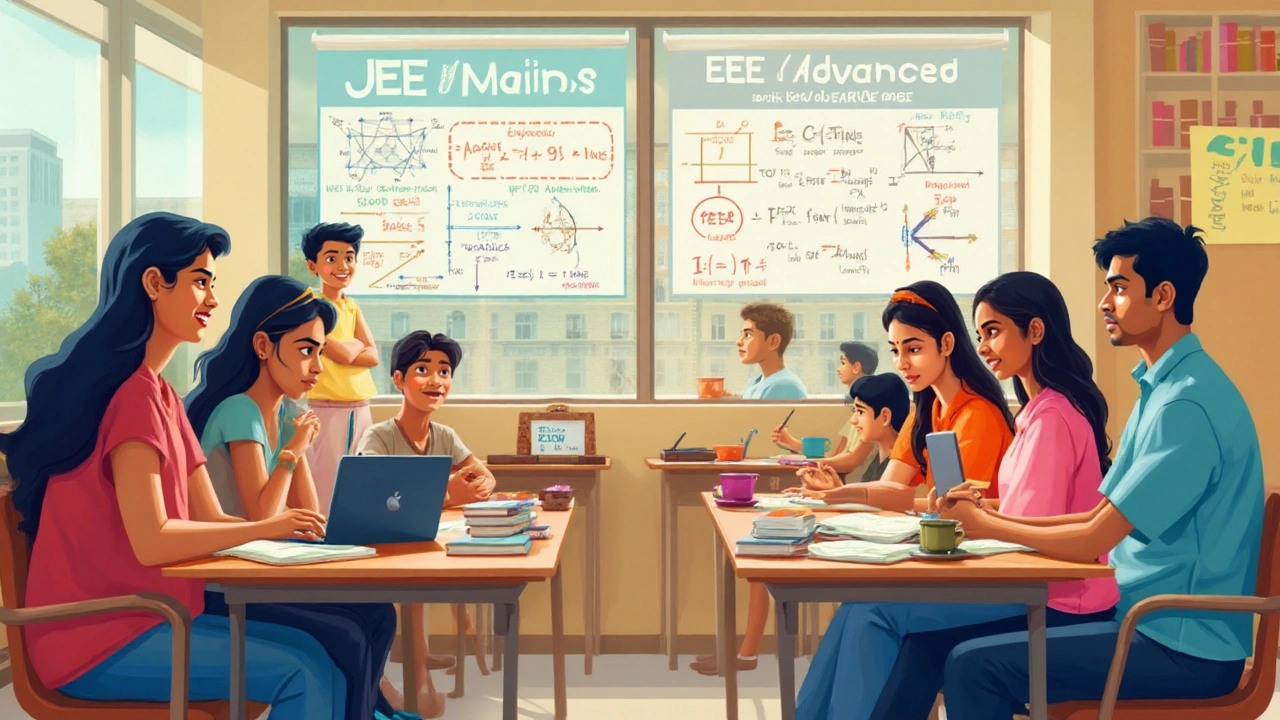
You’d think two of India’s most famous engineering exams, JEE Mains and JEE Advanced, would be more alike. But from the moment you start preparing, the differences stare you down. Every year, around a million students sit for JEE Mains. Only the top 2.5 lakh get to try for JEE Advanced. The stakes? Entry to India’s best engineering colleges. Getting into an IIT isn’t just about being a bookworm—it’s about knowing what you’re up against before you even start revising formulas or solving mock papers.
Breaking Down the Basics: What Sets JEE Mains Apart from JEE Advanced?
The differences start with eligibility. JEE Mains, the first hurdle, is open to anyone who finished Class 12 with Physics, Chemistry, and Maths. Whether you studied at CBSE, ICSE, or any recognized state board, you’re eligible as long as you passed your board exams in the last two years, or are appearing this year. No age limit holds you back for Mains, other than the usual “complete your schooling” catch. JEE Advanced, on the other hand, is by invite only. Crack Mains, and if you’re in the top 2,50,000, you’re in. Miss that cut-off? No second chances that year.
Let’s talk patterns. JEE Mains is a computer-based test with two papers—Paper 1 (the main one, for B.E./B.Tech) and Paper 2 (for architecture and planning). Paper 1 has 90 questions, 30 each from Physics, Chemistry, and Maths. But you only answer 75 (25 per subject)—so even picking which questions to skip is a strategy. Each correct answer nets 4 marks, wrong ones take off 1 mark. Total marks: 300. The vibe here is speed and accuracy. Questions come straight out of your Class 11 and 12 NCERTs, with a good dose of application and calculation tricks tossed in.
Get past the Mains filter, and JEE Advanced feels like a whole new ball game. Here, there are two compulsory papers, each 3 hours. The questions? Unpredictable. Advanced’s claim to fame is its focus on concepts and logical reasoning, not just quick solves or memory power. While the exam is conducted online, the pattern shifts each year. In some editions, a single question can reward you +3, +4, sometimes more, and also penalize you differently. Partial marking, assertion-reason questions, and single/double-correct multiple-choice are all on the table. Problem-solving forms the heart of every section. You might face questions where even the smartest don’t get it right the first time. That’s JEE Advanced for you.
Another key difference is the institutes they unlock. A strong JEE Mains result opens doors to NITs, IIITs, and state-funded engineering colleges. Scoring sky-high in Mains can lead to scholarships or reserved seats in good local colleges too. But JEE Advanced is the literal gatekeeper to the iconic IITs—those campuses that feature in every parent's dream narrative. It also helps you land seats at IISc Bengaluru and a handful of other top research institutes, but only if you ace the Advanced. In 2024, the median Advanced score for IIT admissions was just above 125 out of 360—evidence of just how tough the ride gets.
Talk about attempts. You can have up to three tries at JEE Mains (once each for three years), and you can appear for up to two consecutive years for Advanced, but only after you qualify via Mains. So if you sat for Class 12 in 2025, you can take Advanced in 2025 and 2026, but not after that. It’s a tight window.
Stakes are higher for reservation and quotas too. Both exams follow the rules set by the Indian government—seats for SC/ST/OBC/EWS, with varying cut-offs and relaxations, especially when it comes to ranks and qualifying marks.
| Criteria | JEE Mains | JEE Advanced |
|---|---|---|
| Eligibility | Passed/appearing in Class 12 with Physics, Chemistry, Maths | Top 2,50,000 Mains qualifiers, max 2 attempts |
| Attempts Allowed | 3 in consecutive years | 2 in consecutive years |
| Questions & Marking | 90 questions; +4 for correct, -1 for wrong | Varies, partial marking, changing pattern |
| Level of Difficulty | Moderate, NCERT-based | Very high, concept-based, unpredictable |
| Colleges Accepted | NITs, IIITs, state-funded | IITs, IISc, top research |
| Mode | Computer-based | Computer-based |
| Exam Frequency | 2 times a year | Once a year |

Exam Strategy, Syllabus, and Mindset: What You Don’t Find in the Standard Guidebooks
If you’re prepping for both, you’ll notice that cracking Mains isn’t just about knowing your textbooks. It’s about smart time management, staying calm under pressure, and shaving seconds off calculations. With JEE Mains, there’s no time for perfection—accuracy gets you further than brute speed or memorizing loads of theory. Mock tests play a big role here. In 2024, toppers spent an average of 8-10 hours a day on revisions two months before the exam, taking at least 15 full-length mock tests to get a grip on the pattern. Many used online tools—NTA’s mock platform, for example—to simulate the real experience and battle nerves.
Advanced prep is a whole different animal. The JEE Advanced syllabus isn’t longer, but it digs deep. Questions twist concepts in ways most students haven’t seen before. If you’re aiming high, you can’t just “study hard”—you need to think out of the box. Past question papers show that more than 60% of questions in Advanced are ‘unique’ every year—meaning they aren’t repeats and are often in new formats. Doing extra problems from foreign Olympiads or tough coaching material helps build the kind of problem-solving skills that experts say are essential for this phase. It’s common for successful candidates to start prepping for Advanced while they’re still studying for Mains, but switch gears in the month after Mains finishes.
One habit that matters for both: keeping up with recent trends. The National Testing Agency tweaked JEE Mains question styles in 2023 and 2024, adding more application-based and assertion-reason questions. In Advanced, the marking scheme and the pattern have changed nearly every year for the last 5 years—sometimes by a small tweak, sometimes drastically. If you don’t keep updated, you walk into the hall with a disadvantage. Following official websites or trusted YouTube channels becomes a part of daily study. Also, don’t underestimate the value of group study for Advanced—explaining your approach to a tricky question is the best way to spot your own weak logic.
Stress management is no less important. Exam burnout is real, and nothing kills performance quicker. Candidates who carve out downtime—sports, music, or even just a daily walk—often stay sharper. In a survey by a popular Indian EdTech company in 2024, 73% of students who cleared Advanced said balancing hobbies helped them keep their sanity during prep season. At the same time, keeping sleep routines steady and handling social media distractions save loads of time and energy.
Mastering previous year question papers can’t be emphasized enough. In Mains, recurring topics like Coordinate Geometry, Electrostatics, Organic Reaction Mechanisms, and Application of Derivatives take up nearly 50% of paper weightage each year. In Advanced, while the topics are much the same, the style is unpredictable, so doing diverse question sets is more helpful than rote learning.

Tips, Myths, and Facts: What Every JEE Aspirant Should Know
The myths swirling around the JEE exams are endless. One of the most common: only super-geniuses clear Advanced. Stats say otherwise. Over half of successful candidates in 2024 started as just “average” in Class 11, but hit their stride through consistent practice and timed mock sessions. Another: you need to study all night, every night. Research backs the opposite—students hitting 6-8 hours with solid, focused work outdo those clocking long, distracted hours.
Another big factor is choosing coaching, or going solo. Coaching isn’t a must. About 28% of successful JEE Advanced candidates in 2024 studied entirely on their own, using online resources, free test series, and YouTube lectures. What matters is discipline and seeking help for difficult topics when stuck. Form your own plan, but don’t be afraid to tweak it as exams approach.
Busting another myth: Language doesn’t trip you up. Both Mains and Advanced let you pick between English and Hindi (and some regional languages for Mains). In the last two years, over 11% of Mains applicants chose Hindi or another language—and their average scores were within 3% of the English-medium crowd. Don’t stress about your chosen language, just ensure your resources and practice are in sync.
For those shooting for Advanced, cut-off marks can get confusing. Unlike Mains, which gives you an All India Rank, Advanced uses a mix of subject-wise and aggregate cut-offs. These cut-offs change each year, based on how tough the questions are and the performance pool. In 2024, the minimum qualifying marks hovered around 11% per subject, but the real fight was in the rank list. Getting a safe zone? Past trends say, get at least 35-40% marks to be in the running for a mainstream IIT branch.
Don’t forget important documents and deadlines. Every year, hundreds of students miss out because of a missed photo upload, an error in the application, or not reading the official notification email. In 2025, there’s an added verification step for Advanced, so double-check everything and keep copies handy—including ID proofs, board marks, and reserved category certificates if applicable.
Your health on exam day matters. Eat light, wear comfy clothes, and keep water handy (as the rules allow). Mains allows you to appear twice a year—grab both chances, because application patterns show lots of top candidates improve their scores in the second attempt.
- Use flashcards for formula revision—quick, repeatable, effective.
- Join doubt solving groups online; they often crack a question faster than digging through textbooks.
- Check the JEE Mains cutoff for your target college each year—it shifts with trends.
- Prioritize mental health; even a 10-minute meditation break pays off during crunch time.
If you’re thinking about the difference between JEE Mains and JEE Advanced, it boils down to this: Mains tests what you know; Advanced tests how you think. From eligibility to exam pattern, from question complexity to what doors open up after you score, every step is distinct. It’s tough, it’s stressful—and for some, it’s even fun (believe it or not). Armed with facts, a solid plan, and a calm mindset, you’re already ahead of the pack. Go chase down that IIT dream; you’re now better informed than most who start.
